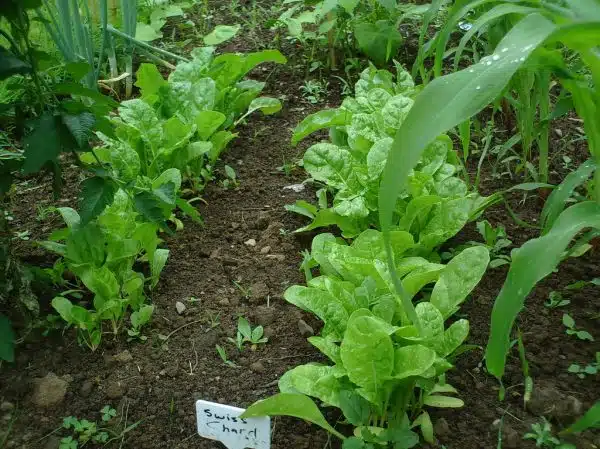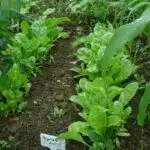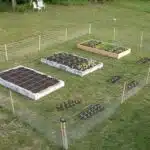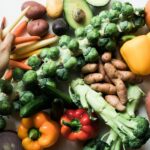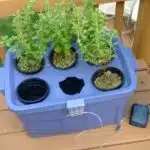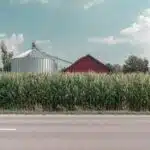As a vegetable gardening expert, one of the most important considerations when planning and planting your garden is determining how much to plant per person. This calculation can vary depending on factors such as the size of your family, their dietary preferences, and the amount of space available for gardening.
Calculating the appropriate amount of vegetables to grow per person is essential for ensuring that your garden provides enough food to meet your family’s needs throughout the growing season. It can also help you avoid overplanting and wasting resources or underplanting and having a shortage of fresh produce. In this article, we will explore various factors that affect the amount of vegetables needed per person in a vegetable garden and provide guidelines on how to make accurate calculations for your own garden.
Factors Affecting How Much To Plant
When planning how much to plant in your vegetable garden, there are several factors to consider. One of the most important is the type of gardening you will be doing. Container gardening and vertical gardening techniques can greatly impact how much you should plant per person.
Container gardening involves planting in pots or other containers rather than in the ground. This method allows for greater control over soil quality and moisture levels, but it also limits the amount of space available for plants to grow. As a result, you may need to plant more per person than if using traditional methods.
Vertical gardening, on the other hand, involves growing plants up trellises or other structures rather than out across the ground. This technique can be especially useful for small gardens or those with limited space. However, it may also require more plants per person since they won’t have as much physical space to spread out and produce fruits or vegetables.
Family Size And Dietary Preferences
When planning a vegetable garden to feed your family, it’s important to consider family size and dietary restrictions. The amount of vegetables needed will vary based on the number of people in your household and their individual dietary needs. For example, if you have a large family with several children, you’ll need to plant more vegetables than if you’re only feeding two people.
Meal planning is also an important consideration when deciding how much to plant per person. If your family enjoys eating fresh salads every day, you’ll need to plant more leafy greens such as lettuce and spinach. On the other hand, if your family prefers heartier meals like stews and soups, you may want to focus on planting root vegetables like potatoes and carrots.
It’s also important to take into account any dietary restrictions that your family members may have. If someone in your household is vegetarian or vegan, for example, you may want to focus on planting crops like beans, peas, and soybeans that are high in protein. Additionally, if anyone in your household has food allergies or intolerances, you’ll need to plan accordingly by avoiding planting crops that could trigger allergic reactions.
Now that we’ve discussed the importance of considering family size and dietary preferences when planning a vegetable garden, let’s move onto the next step: determining how much available garden space you have for planting.
Available Garden Space
When determining the amount of space to allocate for each vegetable in the garden, size of the vegetable should be taken into consideration. Furthermore, the amount of sunlight the variety of vegetable requires for optimal growth should be taken into account. Generally, larger vegetables such as squash and pumpkins require more space than smaller vegetables like peppers and green beans. Additionally, some vegetables may require more sunlight than others, such as tomatoes and melons, so a sunnier location should be provided for these varieties.
Vegetable Size
As a vegetable gardening expert, it is important to consider the variation in sizes and nutritional values of vegetables when determining how much to plant per person in the garden. Some vegetables, such as leafy greens and herbs, have a smaller yield per plant but are packed with essential vitamins and minerals. Other vegetables, such as tomatoes and squash, can produce a larger yield per plant but may not be as nutrient-dense. It is important to strike a balance between variety and quantity when planning your garden.
For those with limited available garden space, growing dwarf vegetables can be a great option. These varieties are specifically bred to be smaller in size while still producing a good yield. For example, dwarf tomatoes only grow to about 2 feet tall but can produce up to 60 cherry-sized tomatoes per plant. This allows for more plants to be grown in a smaller area without sacrificing productivity or nutrition.
In conclusion, when deciding how much to plant per person in the vegetable garden, it is important to take into account the variation in sizes and nutritional values of different vegetables. Growing dwarf varieties can also be an effective way to maximize space while still producing plenty of fresh produce for your family or community. With careful planning and consideration of these factors, your vegetable garden can provide both quantity and quality for those you serve.
Sunlight Requirements
Another important factor to consider when planning a vegetable garden in limited space is the amount of sunlight available. Most vegetables require at least six hours of direct sunlight per day to thrive, but not all plants have the same requirements. Some shade-tolerant vegetables, such as lettuce and spinach, can grow in areas with less direct sunlight or even partial shade. However, it is important to note that while these plants may still produce a yield, they may not reach their full potential without adequate sunlight.
To maximize space and sunlight in a small garden plot, vertical gardening can be an effective solution. This method involves growing plants on trellises or other support structures to make use of vertical space rather than just horizontal ground space. This allows for more plants to be grown in a smaller area while still allowing for adequate sunlight exposure. It is important to choose appropriate support structures based on the size and weight of the plants being grown.
In conclusion, considering the amount of sunlight available and utilizing vertical gardening techniques can help maximize productivity in a small garden space. Additionally, selecting shade-tolerant vegetables can provide additional options for those with limited direct sunlight exposure. By carefully planning your garden layout and taking into account these factors, you can create a thriving vegetable garden that provides fresh produce for yourself and others you serve.
Growing Season Length
The length of the growing season determines the amount and variety of vegetables that can be grown in a garden. The planting schedule should be determined according to the average first and last frost dates in the area. For example, if the average first frost date is October 15th, then the growing season will be approximately 150 days. This is important because different crops have different maturity times and require varying lengths of time to reach their full potential.
Crop selection is also an important consideration when planning a garden’s growing season. Some vegetables, such as tomatoes and peppers, require a long growing season to mature fully. These crops should be started indoors before being transplanted into the garden after the danger of frost has passed. Other crops, such as peas and lettuce, can tolerate cooler temperatures and can be planted earlier in the spring or later in the fall for an extended harvest period.
In addition to selecting appropriate crops for your region’s growing season length, it is also important to consider crop rotation and succession planting to maximize yields. Planning ahead and rotating your crops each year will help reduce soil-borne diseases, pests, and nutrient depletion. Succession planting involves staggering plantings throughout the growing season so that new plants are ready to replace those that have finished producing. By implementing these strategies along with proper timing and crop selection, you can ensure a bountiful harvest from your vegetable garden.
As we’ve seen, understanding the length of your region’s growing season is crucial when deciding what and when to plant in your garden. In our next section on vegetable types and yields, we’ll explore how choosing specific varieties can increase yields while still maintaining optimal growth conditions for each crop.
Vegetable Types And Yields
As we move on to the next topic, it is important to consider the amount of vegetables that need to be planted per person. This will depend on various factors such as the dietary needs of each individual and the yield of each vegetable type. Before planting, it is crucial to carefully select seeds that will thrive in your specific climate and soil conditions.
Proper planting techniques also play a significant role in determining the yield of your garden. Some crops require deeper planting while others should be planted shallower. Understanding the individual needs of each crop will ensure optimal growth and production. Additionally, proper spacing between plants is vital for best results.
Harvest timing and storage options are also important considerations when planning a vegetable garden. Harvesting at peak ripeness ensures maximum flavor and nutritional value. It is essential to store vegetables properly after harvest in order to maintain their quality and freshness for longer periods of time. Several storage options include root cellars, canning, freezing or dehydrating.
Moving forward into our next section about soil quality and fertility, it is important to remember that these factors play a crucial role in determining the success of your vegetable garden. By properly preparing your soil with nutrient-rich composts or fertilizers and maintaining its health through regular maintenance practices such as crop rotation or cover cropping, you can achieve a bountiful harvest year after year.
Soil Quality And Fertility
To ensure the success of your vegetable garden, it is important to pay attention to soil quality and fertility. Soil testing is an essential step in determining the health and nutrient content of your soil. This information can guide you in making informed decisions about fertilizer application.
Soil testing can be done through a variety of methods, including at-home kits or professional laboratory analysis. The results will provide you with information on pH levels, nutrient deficiencies, and potential toxicities. With this knowledge, you can tailor your fertilizer application to the specific needs of your soil and plants.
Fertilizer application is a crucial aspect of maintaining healthy soil fertility. It is important to choose a fertilizer that aligns with the needs identified through soil testing. This could include organic options such as compost or manure, or synthetic options like nitrogen-based fertilizers. Applying too much fertilizer can lead to environmental damage and plant stress, so it is important to follow recommended dosage guidelines.
Moving beyond just planting per person in the vegetable garden, ensuring proper soil quality and fertility will not only benefit your own gardening efforts but also contribute positively towards serving others through community gardens or donating excess produce to food banks. Next up, we will explore how climate and weather conditions impact vegetable growth.
Climate And Weather Conditions
Successful vegetable gardening requires an understanding of the climate and weather conditions in your region. Growing vegetables can be challenging under adverse weather conditions such as high winds, frost, heavy rain, or severe heat waves. These conditions can cause damage to plants or prevent them from growing to maturity. Therefore, it is essential to know the average temperature range, rainfall patterns, wind direction, and other climatic factors for your area.
Microclimates are small pockets of environmental conditions that differ from the surrounding area. For example, a sheltered spot near a wall may be warmer than an open area because it receives more sunlight and less wind. Understanding microclimates can help you choose the best location for planting different crops in your garden. You can also use various techniques such as creating windbreaks or shading devices to modify microclimate conditions in your garden.
Growing challenges such as pests and diseases are often related to weather conditions. High humidity levels and moist soil can create favorable environments for fungal diseases that affect some vegetables like tomatoes or cucumbers. On the other hand, hot and dry weather conditions may attract pests like aphids or spider mites that suck plant sap causing stunted growth or wilting. A preventive approach based on crop rotation, good soil management practices, and selecting resistant varieties can help mitigate these challenges effectively.
As we move into companion planting techniques, it is vital to note how climate and weather play a significant role in determining how successful our efforts will be.
Companion Planting
As we have discussed in the previous section, climate and weather conditions play a crucial role in determining the success of a vegetable garden. However, another critical factor that contributes to the health of your crops is companion planting. This technique involves planting two or more different plant species together to achieve mutual benefits such as pest control and nutrient uptake.
Companion planting can be an effective way to improve soil health without the use of chemical fertilizers. For example, legumes such as beans and peas fix nitrogen in the soil, which can benefit neighboring plants like tomatoes and peppers that require high levels of this nutrient. Additionally, certain plants produce natural compounds that repel pests or attract beneficial insects, reducing the need for pesticides.
When planning your vegetable garden, consider incorporating companion planting strategies to promote a healthy ecosystem and increase the yield of your crops. Planting complementary species together can lead to better soil structure, reduced erosion, and healthier plants overall. By taking steps towards creating a sustainable garden environment through techniques like companion planting and responsible soil management practices, you will not only serve yourself but also contribute positively to the greater community at large.
As we continue our discussion on improving crop yields in your vegetable garden, it is important to address crop rotation. This practice involves changing the location of specific crops each year to prevent depletion of soil nutrients and reduce pest populations. By rotating crops in this manner, you can minimize disease outbreaks while maintaining optimal soil health for each plant species. In our next section on crop rotation strategies, we’ll discuss tips for successful implementation and how it can significantly improve your harvest season after season.
Crop Rotation
One of the most important aspects of successful vegetable gardening is crop rotation. Crop rotation refers to the practice of planting different types of crops in different areas of the garden each year. This helps to prevent soil-borne diseases from building up and reduces pest problems. By rotating crops, you can also ensure that your soil remains fertile and healthy, allowing your plants to grow strong and produce bountiful harvests.
Composting benefits are a key component of successful crop rotation. By adding compost to your garden beds each season, you can replenish nutrients in the soil that may have been depleted by previous crops. Compost also helps to improve soil structure, making it easier for roots to penetrate and access water and nutrients. Additionally, compost can help suppress certain plant diseases and pests, further reducing the need for chemical interventions.
Pest management is another important consideration when practicing crop rotation. By rotating crops and planting different varieties each year, you can reduce the risk of pests becoming established in your garden. You can also use companion planting strategies, such as planting marigolds or other pest-repelling plants alongside your vegetables, to help deter insects and other pests. Regular monitoring and early intervention are also critical for preventing pest outbreaks from getting out of hand.
Transition: Now that we’ve discussed the importance of crop rotation for a healthy vegetable garden, let’s turn our attention to another key strategy for maximizing yields: succession planting.
Succession Planting
Succession Planting:
To maximize your vegetable garden’s yield, it’s essential to engage in succession planting. This method involves planting crops in intervals so that you’ll have a steady supply of fresh produce throughout the growing season. To start, carefully select the crops you want to plant and determine their growth rates. You can use this information to develop a planting schedule that ensures each crop is harvested at its peak.
When selecting crops for succession planting, prioritize those with shorter maturity periods. These plants will be ready for harvest sooner, allowing you to replant the area with another crop. It’s also important to consider how long each crop will produce before reaching its end-of-life stage. By staggering your plantings, you can ensure a continuous harvest and reduce waste.
By implementing succession planting techniques in your vegetable garden, you’ll be able to enjoy a bountiful harvest throughout the growing season. However, it’s important to keep track of your planting schedule and stay on top of your crop selection. With careful planning and attention to detail, you can create an abundant and sustainable garden that provides fresh produce for yourself and others.
Transition: Now that you have an understanding of how succession planting can benefit your garden, let’s dive into another critical aspect of vegetable gardening: seed starting vs. direct sowing.
Seed Starting Vs. Direct Sowing
As we discussed in the previous section, succession planting is a great way to maximize your vegetable garden yield. Another way to ensure a bountiful harvest is by starting seeds indoors. Seed starting has numerous benefits, including greater control over the growing conditions and earlier harvests. When you start your seeds indoors, you can provide them with optimal temperature, light, and moisture levels to ensure they grow strong and healthy.
Direct sowing, on the other hand, involves planting seeds directly into the soil outside. While it may seem less convenient than seed starting, direct sowing has its advantages. For one thing, it eliminates the need for transplanting seedlings from indoor containers to outdoor beds. Additionally, many vegetables prefer to be directly sown into their final location rather than being transplanted.
When deciding whether to start your seeds indoors or sow them directly outside, consider factors such as the climate in your area and the types of vegetables you want to grow. Some vegetables have longer growing seasons and require a head start indoors while others can be successfully direct-sown outdoors.
Next up in our discussion of maximizing your vegetable garden yield is staggered planting. This technique involves staggering your planting times so that you have a continuous supply of fresh produce throughout the growing season. Stay tuned for tips on how to implement staggered planting in your own garden!
Staggered Planting
Staggered planting is a gardening technique that involves planting crops at different times to ensure a continuous harvest throughout the growing season. This method works well for both small and large gardens, and it allows gardeners to make the most of their available space by maximizing yield. By staggering your planting, you can enjoy early and late harvests, which means more fresh produce for you and your family.
Overlapping crops is one way to utilize staggered planting. This involves planting two or more crops in the same area but with different maturity dates. For example, you could plant lettuce and radishes together since lettuce matures faster than radishes. By doing so, you can harvest the lettuce first and then let the radishes continue to grow until they are ready for harvesting. Spacing is another important factor when using this technique as it ensures that each crop gets enough sunlight, water, and nutrients.
Another benefit of staggered planting is that it reduces waste since you can control the amount of produce harvested at any given time. Rather than having an overwhelming amount of vegetables all at once, this method allows gardeners to spread out their harvest over several weeks or months. Additionally, staggered planting helps prevent pests and diseases from taking hold since new plants are introduced periodically throughout the season.
Incorporating staggered planting into your vegetable garden can be a rewarding experience that yields fresh produce throughout the growing season. By utilizing overlapping crops and proper spacing techniques, you can enjoy early and late harvests while reducing waste and preventing pest infestations. In the next section, we will discuss various harvesting and preservation methods that will help you make the most of your bountiful crop.
Harvesting And Preservation Methods
Harvesting and Preservation Methods:
Once your vegetable garden is thriving, it’s time to start thinking about how to preserve your bounty for future use. Canning techniques have been around for centuries and remain a popular way to keep vegetables fresh long after they’ve been harvested. To begin canning, you’ll need jars, lids, and a large pot for boiling the jars. Begin by washing and sterilizing the jars and lids, then fill them with vegetables while leaving enough space at the top for air. Boil the jars in water for a set amount of time depending on the vegetable type, then remove them from the pot and let them cool.
Freezing is another preservation method that works well for many types of vegetables. Before freezing, it’s essential to blanch vegetables in boiling water for a short period of time to stop enzyme activity that can cause spoilage. Once blanched, place vegetables in freezer bags or containers with as little air as possible to prevent freezer burn. Another freezing method is flash freezing, where you spread out individual pieces of produce on a baking sheet and freeze until solid before transferring them into containers.
By utilizing these preservation methods correctly, you can enjoy your home-grown veggies year-round! However, it’s important to note that different vegetables require different preservation methods based on their water content and other factors. In the next section, we will explore how to calculate vegetable needs based on these factors so that you can maximize your harvest while minimizing waste.
Calculating Vegetable Needs
After successfully harvesting and preserving your vegetables, it’s time to start planning for the next growing season. One of the most important factors to consider is how much to plant per person in your vegetable garden. This will ensure that you have enough fresh produce to feed your family throughout the year.
When it comes to seed selection, it’s important to choose varieties that are well-suited for your growing zone and climate. Consider the number of people in your household and their individual preferences when selecting crops. For example, if you have a large family who enjoys eating tomatoes, you may want to plant several different varieties of tomato plants.
Harvest timing and storage options are also critical components of maximizing your garden’s potential. It’s important to harvest crops at the right time to ensure optimal flavor and nutrition. Additionally, proper storage techniques will help extend the shelf life of your produce. Here are some essential tips for maximizing your garden’s potential:
- Plan ahead: Determine what crops you want to grow and how much space they’ll need.
- Rotate crops: Planting different crops in different locations each year can help prevent soil-borne diseases.
- Mulch: Adding a layer of organic matter on top of the soil can help retain moisture, suppress weeds, and improve soil health.
- Water wisely: Water deeply and less frequently rather than shallowly and often.
By following these tips, you can create a bountiful vegetable garden that provides fresh produce for your family all season long.
Essential Tips For Maximizing Your Garden’s Potential
To maximize the potential of your vegetable garden, there are a few essential tips to keep in mind. One option to consider is container gardening, which allows you to grow plants in small spaces and control the soil conditions more easily. Containers can be made from a variety of materials, including plastic, clay, or wood, and should be at least 6 inches deep for most vegetables. Be sure to choose sturdy containers that won’t tip over in strong winds or heavy rain.
Another way to make the most of your garden space is through vertical gardening. This technique involves growing plants up trellises, fences, or walls rather than along the ground. Not only does this save space, but it can also help prevent pests and diseases by keeping plants off the ground. Some vegetables that do well with vertical gardening include cucumbers, tomatoes, and beans.
When deciding how much to plant per person in your vegetable garden, it’s important to consider factors such as eating habits and dietary restrictions. A good rule of thumb is to plant enough for each person to have 2-3 servings of vegetables per day. Keep in mind that some crops may produce more than others – for example, a single zucchini plant can yield an abundance of squash – so plan accordingly and be prepared to preserve or share any excess harvests. By following these tips and utilizing techniques like container and vertical gardening, you can maximize your garden’s potential and provide fresh, healthy produce for yourself and those around you without taking up too much space or time.
Conclusion
When it comes to vegetable gardening, knowing how much to plant per person is essential for a successful harvest. Several factors influence the amount of vegetables you need to grow, such as family size and dietary preferences, available garden space, growing season length, vegetable types and yields, staggered planting, and harvesting and preservation methods.
To calculate your vegetable needs accurately, consider all these factors and use a garden planner or seed spacing chart. For example, a family of four with a preference for fresh tomatoes may need to plant 12-16 tomato plants in a 10×10 garden bed. Similarly, if you want to preserve your harvest through canning or freezing, you may need to plant extra vegetables.
According to the National Gardening Association’s survey, 70% of American households are growing some type of food at home. This trend is not only cost-effective but also promotes healthy eating habits and sustainability. By following our essential tips for maximizing your garden’s potential and calculating your vegetable needs accurately, you can join this trend and enjoy fresh produce straight from your backyard. Happy gardening!
Image Credits
- “Vegetable Garden Growing” by James P. Mann (featured)

